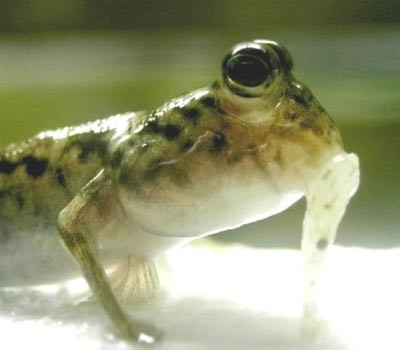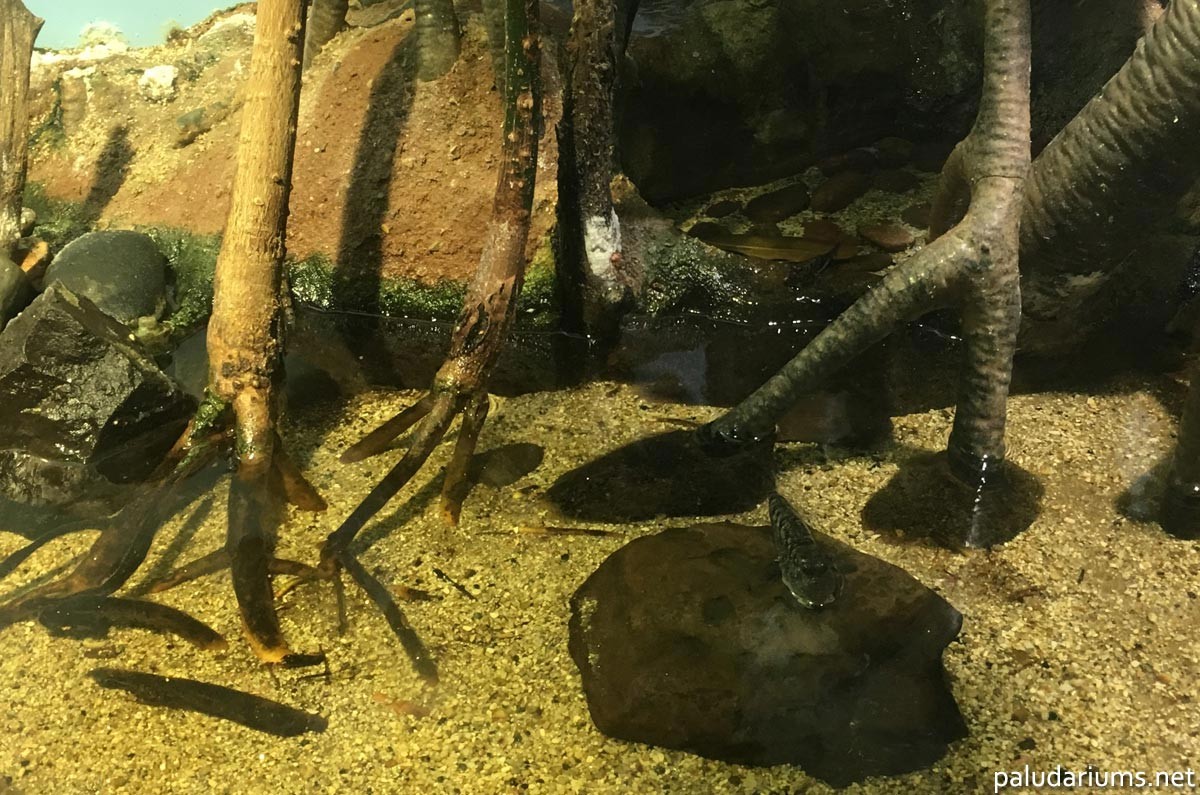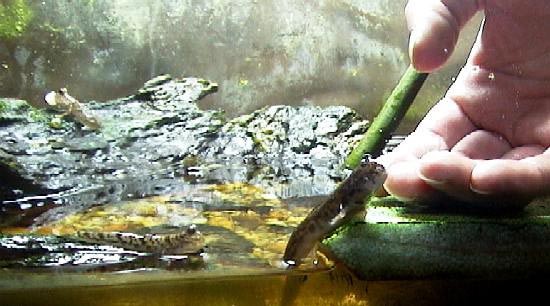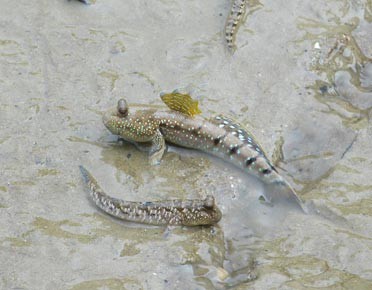Can Mudskippers Be Kept As Pets? Absolutely! Mudskippers, those fascinating amphibious fish, can make unique and engaging pets with the proper setup and care. At PETS.EDU.VN, we’ll guide you through everything you need to know about providing a happy and healthy life for these captivating creatures, from creating the perfect paludarium to understanding their dietary needs and behavior. Dive into the world of mudskipper ownership and discover how to create a thriving semi-aquatic environment. Learn about mudskipper care, habitat setup, and responsible pet ownership.
1. Understanding Mudskippers: Nature’s Amphibious Wonders
Mudskippers are extraordinary fish that have adapted to thrive both in and out of water. Native to the tropical and subtropical regions of the Indo-Pacific and West Africa, these unique creatures inhabit mudflats, mangrove swamps, and coastal areas. Their ability to breathe through their skin and specialized pectoral fins allow them to navigate land with surprising agility.
- Amphibious Adaptations: Mudskippers possess several key adaptations that enable their semi-terrestrial lifestyle. They can breathe through their skin, the lining of their mouth, and gills, allowing them to survive out of water for extended periods. Their bulging eyes, positioned on top of their heads, provide excellent panoramic vision, crucial for spotting predators and prey in their muddy environments.
- Behavioral Traits: Mudskippers are highly active and intelligent fish. They are known for their playful behavior, often seen hopping, skipping, and climbing on rocks and mangrove roots. They are also territorial and exhibit complex social interactions, including displays of dominance and courtship rituals.
- Natural Habitat: In their natural habitat, mudskippers live in brackish water environments characterized by fluctuating tides and muddy substrates. These areas are typically rich in invertebrates, which form the basis of their diet.
2. Is a Mudskipper the Right Pet for You?
Before bringing a mudskipper home, it’s crucial to assess whether you can provide the specialized care they require. Mudskippers are not your average aquarium fish and demand a dedicated owner willing to invest time and effort in creating a suitable habitat.
- Commitment Level: Mudskippers require a long-term commitment. With proper care, they can live for several years in captivity.
- Space Requirements: Mudskippers need a spacious enclosure that replicates their natural environment, with both land and water areas.
- Dietary Needs: Mudskippers are carnivores and require a varied diet of live, frozen, and occasionally dry foods.
- Temperament: Mudskippers can be territorial and may not be suitable for community tanks with other fish.
Essential Questions to Ask Yourself:
- Do I have the space for a sufficiently large paludarium?
- Am I prepared to maintain brackish water conditions?
- Can I provide a varied diet of live and frozen foods?
- Am I comfortable with the territorial nature of mudskippers?
- Do I have the time to dedicate to regular tank maintenance?
3. Setting Up the Perfect Mudskipper Paludarium
Creating the ideal habitat is essential for the health and well-being of your mudskippers. A paludarium, a semi-aquatic enclosure that combines both terrestrial and aquatic elements, is the most suitable setup for these amphibious fish.
3.1. Tank Size and Dimensions
- Minimum Size: A 20-gallon long tank is the minimum recommended size for a small group of mudskippers.
- Shape: A long, shallow tank is preferable to a tall one, as it provides more surface area for both land and water.
- Volume Ratio: Aim for a 50/50 split between land and water volume.
3.2. Substrate and Landscaping
- Substrate: Use a mix of fine sand and gravel for the land area, allowing for easy digging and burrowing.
- Water Area: The water depth should not exceed 6-10 inches in the deepest parts.
- Landscaping: Incorporate rocks, driftwood, and mangrove roots to create a natural-looking environment and provide climbing opportunities.
- Visual Barriers: Add plants and other decorations to break up sightlines and reduce aggression between mudskippers.
3.3. Water Parameters
- Brackish Water: Mudskippers require brackish water with a specific gravity between 1.005 and 1.015.
- Temperature: Maintain a water temperature between 77°F and 86°F (25°C to 30°C).
- pH: The ideal pH range is between 8.0 and 8.5.
- Filtration: Use a filter suitable for brackish water to maintain water quality.
3.4. Lighting and Heating
- Lighting: Provide full spectrum lighting to mimic natural sunlight and promote plant growth.
- Heating: Use a submersible heater to maintain the desired water temperature.
- Basking Area: Provide a basking area with a heat lamp to allow mudskippers to thermoregulate.
3.5. Plants and Decorations
- Brackish-Tolerant Plants: Java moss, Java fern, and Anubias are excellent choices for a mudskipper paludarium.
- Mangrove Roots: Mangrove roots add an authentic touch to the environment and provide climbing surfaces.
- Artificial Decorations: Resin roots and other artificial decorations can be used to enhance the aesthetic appeal of the tank.
4. Choosing the Right Mudskipper Species
There are over 30 species of mudskippers, but only a few are commonly available in the pet trade. When selecting mudskippers, consider their adult size, temperament, and specific care requirements.
4.1. Popular Mudskipper Species
| Species | Size | Temperament | Notes |
|---|---|---|---|
| Atlantic Mudskipper | Up to 10 in | Hardy omnivore | Requires a larger tank |
| Dwarf Mudskipper | Small | Territorial | Suitable for smaller tanks, but needs plenty of hiding places |
| Periophthalmus Septermradi | Up to 4 in | Relatively peaceful | The species name refers to the number of spines (seven) on the dorsal fin |




4.2. Things to Consider When Choosing a Species
- Adult Size: Ensure that the species you choose will be comfortable in your tank size when fully grown.
- Temperament: Some species are more aggressive than others. Research the temperament of the species you are interested in to ensure they are compatible with your setup.
- Availability: Not all species are readily available in the pet trade. Check with your local pet store or breeder to see what species are available.
5. Feeding Your Mudskippers: A Balanced Diet
Mudskippers are carnivores and require a varied diet to thrive in captivity.
5.1. Dietary Requirements
- Live Foods: Offer a variety of live foods, such as crickets, mealworms, and bloodworms.
- Frozen Foods: Supplement their diet with frozen foods, such as brine shrimp, mysis shrimp, and bloodworms.
- Dry Foods: High-quality carnivore pellets can be offered as a supplemental food source.
5.2. Feeding Schedule
- Frequency: Feed your mudskippers once or twice a day.
- Location: Offer food on the land area of the paludarium, as mudskippers prefer to eat out of water.
- Hand-Feeding: Mudskippers can be trained to eat from your hand, creating a unique bonding experience.
5.3. Important Considerations
- Avoid Overfeeding: Overfeeding can lead to obesity and health problems.
- Remove Unaten Food: Remove any uneaten food from the tank to prevent water pollution.
- Variety is Key: Offering a varied diet ensures that your mudskippers receive all the necessary nutrients.
6. Maintaining a Healthy Environment
Regular maintenance is crucial for maintaining a healthy environment for your mudskippers.
6.1. Water Changes
- Frequency: Perform partial water changes of 25% every 1-2 weeks.
- Brackish Water: Use a saltwater mix to maintain the proper salinity levels.
6.2. Tank Cleaning
- Substrate: Clean the substrate regularly to remove debris and uneaten food.
- Glass: Clean the glass to remove algae and mineral deposits.
6.3. Filter Maintenance
- Regular Cleaning: Clean the filter regularly to ensure proper filtration.
- Media Replacement: Replace filter media as needed.
6.4. Monitoring Water Parameters
- Regular Testing: Test water parameters regularly to ensure they are within the ideal range.
- Adjustments: Make adjustments as needed to maintain optimal water quality.
7. Mudskipper Behavior and Social Interactions
Understanding mudskipper behavior is essential for providing proper care and managing their social interactions.
7.1. Territoriality
- Aggression: Mudskippers can be territorial and may exhibit aggression towards each other, especially males.
- Visual Barriers: Provide plenty of visual barriers to reduce aggression and create distinct territories.
- Tank Size: A larger tank can help reduce aggression by providing more space for each individual.
7.2. Communication
- Fin Displays: Mudskippers communicate through fin displays, raising their dorsal fins to signal dominance or attract mates.
- Leaping: They may also leap into the air to communicate with other individuals.
7.3. Burrowing
- Natural Behavior: Some mudskipper species will dig tunnels in the substrate, both to avoid predators and to breed.
- Substrate Depth: Provide a sufficiently deep substrate to allow for burrowing behavior.
8. Common Health Issues and Prevention
While mudskippers are generally hardy fish, they are susceptible to certain health issues if their environment is not properly maintained.
8.1. Common Diseases
- Fungal Infections: Fungal infections can occur if the water quality is poor.
- Bacterial Infections: Bacterial infections can result from injuries or stress.
- Parasitic Infections: Parasitic infections can be introduced through live foods.
8.2. Prevention
- Quarantine: Quarantine new mudskippers before introducing them to the main tank.
- Maintain Water Quality: Maintain optimal water quality through regular water changes and filtration.
- Balanced Diet: Provide a balanced diet to boost their immune system.
- Observe Regularly: Observe your mudskippers regularly for signs of illness.
8.3. Treatment
- Consult a Vet: Consult a veterinarian experienced in aquatic animals for diagnosis and treatment.
- Medications: Medications may be necessary to treat bacterial and parasitic infections.
9. Breeding Mudskippers in Captivity
Breeding mudskippers in captivity is challenging but possible with the right conditions and dedication.
9.1. Creating Breeding Conditions
- Optimal Water Parameters: Maintain optimal water parameters, including temperature, pH, and salinity.
- Spawning Site: Provide a suitable spawning site, such as a cave or tunnel in the substrate.
- Conditioning: Condition the breeding pair with a varied diet of live and frozen foods.
9.2. Courtship and Spawning
- Courtship Displays: Observe the mudskippers for courtship displays, such as fin raising and leaping.
- Spawning: The female will lay eggs in the spawning site, and the male will fertilize them.
9.3. Raising Fry
- Separate Fry: Remove the fry from the main tank to prevent them from being eaten by the adults.
- Fry Food: Feed the fry with infusoria or other small live foods.
- Water Quality: Maintain excellent water quality to ensure the survival of the fry.
10. Ethical Considerations and Responsible Ownership
When keeping mudskippers as pets, it’s crucial to consider the ethical implications and practice responsible ownership.
10.1. Sourcing Mudskippers
- Reputable Breeders: Purchase mudskippers from reputable breeders or pet stores that prioritize animal welfare.
- Avoid Wild-Caught: Avoid purchasing wild-caught mudskippers, as their capture can harm wild populations.
10.2. Providing Proper Care
- Adequate Housing: Provide adequate housing and care to meet the specific needs of mudskippers.
- Environmental Enrichment: Provide environmental enrichment to stimulate their natural behaviors.
10.3. Educating Others
- Share Knowledge: Share your knowledge and experiences with others to promote responsible mudskipper keeping.
- Promote Conservation: Promote conservation efforts to protect mudskipper habitats in the wild.
11. Mudskipper FAQs: Addressing Your Burning Questions
Have more questions about keeping mudskippers as pets? We’ve compiled a list of frequently asked questions to help you provide the best possible care for these fascinating fish.
FAQ 1: What is the ideal tank setup for mudskippers?
A paludarium with a 50/50 split between land and water is ideal. The water should be brackish, and the land area should consist of fine sand and gravel with plenty of rocks and mangrove roots for climbing.
FAQ 2: What do mudskippers eat?
Mudskippers are carnivores and require a varied diet of live, frozen, and occasionally dry foods. Offer them crickets, mealworms, brine shrimp, and carnivore pellets.
FAQ 3: How often should I feed my mudskippers?
Feed your mudskippers once or twice a day, offering food on the land area of the paludarium.
FAQ 4: How often should I perform water changes?
Perform partial water changes of 25% every 1-2 weeks, using a saltwater mix to maintain the proper salinity levels.
FAQ 5: Are mudskippers aggressive?
Mudskippers can be territorial and may exhibit aggression towards each other, especially males. Provide plenty of visual barriers to reduce aggression.
FAQ 6: Can mudskippers live with other fish?
Mudskippers are best kept in a species-only tank due to their territorial nature and specialized environmental requirements.
FAQ 7: How long do mudskippers live?
With proper care, mudskippers can live for several years in captivity.
FAQ 8: Do mudskippers need a basking area?
Yes, mudskippers need a basking area with a heat lamp to allow them to thermoregulate.
FAQ 9: Can I train my mudskipper to eat from my hand?
Yes, mudskippers can be trained to eat from your hand, creating a unique bonding experience.
FAQ 10: Where can I buy mudskippers?
Purchase mudskippers from reputable breeders or pet stores that prioritize animal welfare.
12. Advanced Mudskipper Keeping: Taking Your Care to the Next Level
Ready to delve deeper into the world of mudskipper care? Here are some advanced techniques to optimize their environment and well-being.
12.1. Simulating Tides
- Automated System: Implement an automated system to simulate tides by regularly pumping extra water from a sump into the tank.
- Benefits: This mimics their natural environment and can stimulate breeding behavior.
12.2. Creating a Naturalistic Environment
- Live Plants: Incorporate live plants that thrive in brackish water to create a more naturalistic environment.
- Leaf Litter: Add leaf litter to the land area to provide hiding places and encourage natural foraging behavior.
12.3. Advanced Filtration
- Sump Filter: Use a sump filter to provide superior water quality and increase water volume.
- Protein Skimmer: Add a protein skimmer to remove organic waste and improve water clarity.
13. Expert Tips for a Thriving Mudskipper Paludarium
- Regular Observation: Spend time observing your mudskippers to monitor their behavior and identify any potential health issues early on.
- Experiment with Foods: Experiment with different types of live and frozen foods to find out what your mudskippers enjoy most.
- Maintain a Journal: Keep a journal to track water parameters, feeding habits, and any changes in behavior.
- Join Online Communities: Connect with other mudskipper enthusiasts online to share tips and ask questions.
14. Mudskipper Conservation: Protecting Their Future
As responsible pet owners, it’s essential to be aware of the conservation status of mudskippers and support efforts to protect their natural habitats.
14.1. Habitat Loss
- Mangrove Destruction: Mangrove forests, the primary habitat of mudskippers, are being destroyed at an alarming rate due to deforestation, pollution, and coastal development.
- Climate Change: Climate change is also a threat, as rising sea levels and changing weather patterns can alter mudskipper habitats.
14.2. Conservation Efforts
- Support Organizations: Support organizations that are working to protect mangrove forests and promote sustainable coastal management.
- Reduce Pollution: Reduce your carbon footprint and avoid using products that contribute to pollution.
- Educate Others: Educate others about the importance of protecting mudskipper habitats.
15. Resources for Mudskipper Keepers
- Online Forums: Join online forums dedicated to mudskipper keeping to connect with other enthusiasts and share information.
- Books: Consult books and articles on mudskipper care to learn more about their biology and behavior.
- Veterinarians: Find a veterinarian experienced in aquatic animals to provide medical care for your mudskippers.
16. The Joy of Mudskipper Ownership: A Rewarding Experience
Keeping mudskippers as pets can be a truly rewarding experience. These fascinating fish are intelligent, active, and full of personality. With proper care and dedication, you can provide them with a happy and healthy life in captivity.
- Unique Pets: Mudskippers are unique and engaging pets that offer a glimpse into the natural world.
- Educational: Keeping mudskippers can be an educational experience, teaching you about biology, ecology, and animal behavior.
- Rewarding: Providing proper care for mudskippers and watching them thrive can be incredibly rewarding.
17. Conclusion: Embracing the Mudskipper Adventure
Can mudskippers be kept as pets? Absolutely! With the right knowledge, dedication, and setup, you can successfully keep mudskippers as pets and enjoy the unique joys of owning these amphibious wonders. Remember to prioritize their well-being, provide a suitable environment, and stay informed about their specific needs. Welcome to the wonderful world of mudskipper keeping!
Ready to Learn More?
At PETS.EDU.VN, we’re dedicated to providing comprehensive information and resources for pet owners. If you’re eager to dive deeper into the world of mudskipper care or explore other fascinating pets, we invite you to visit our website. Discover a wealth of articles, guides, and expert advice to help you create a thriving environment for your beloved companions.
Contact Information:
- Address: 789 Paw Lane, Petville, CA 91234, United States
- WhatsApp: +1 555-987-6543
- Website: PETS.EDU.VN
Explore pets.edu.vn today and unlock a world of knowledge and support for all your pet care needs!
Anubias